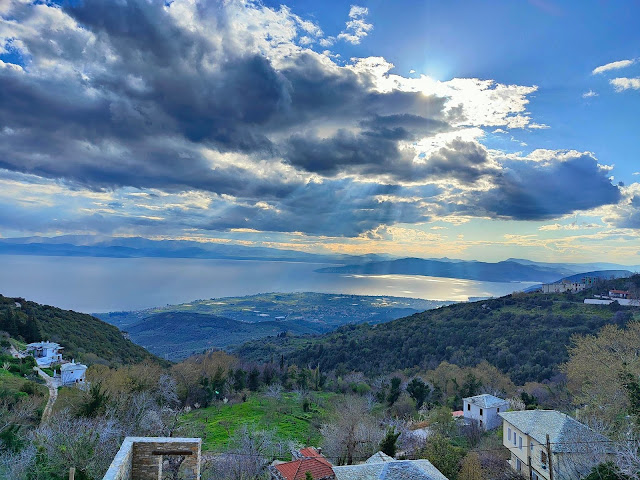Distance: 8,3 km.
Time: 5 hours with stops
Altitude: from 418 m. (Pouri parking lot) to 680 m. (Profitis Elias chapel)
Total elevation gain/loss: 503 m.
Signing: red paint
Drinking water on walk: Panagia Rasova church, Pouri
Last checked: June 2023
Download GPS file: from Wikiloc
. The waterfall of Megalovrachos is located in the Kalokairinos stream, between Zagora and Pouri. It is the largest and most impressive of Pelion, with a height (estimated) of over 50 meters. There is plenty of water in the spring when the snow melts, but in the summer it dries up. It is located in a difficult place and visiting it has certain requirements (adequate `physical condition, suitable shoes). In order to enjoy the special experience, our visit should preferably take place in the months of March-May. In this particular case, before the visit to the waterfall we passed by the chapel Ilias Pouriou and the old monastery of Panagia Rasova, thus making a varied circular walk starting and ending in Pouri. One can go up to Rasova using a concrete road (for cars with increased ground clearance), that opens to the asphalt road between Zagora and Pouri (there is a sign to "Panagia Rasova"in Greek).
Starting from the parking lot of Pouri, we climb to the central church of Agios Dimitrios and continue uphill, following the Makrinitsa-Pouri route in reverse, helped by the red signs. We pass by a building of the water system (for a few meters, if the path is overgrown, we are forced to walk next to it, through the adjacent grove) and continue on an uphill dirt road. Paying attention to the red signs on the left, we enter a path for a while and then again on a road that continues uphill to the small church of Prophitis Elias. Next to the church there is a kiosk and the view to the south and east is excellent.
 |
| View from Profitis Elias |
We continue on the road, which is now descending, and below we turn right entering a grove. We cross a small stream and then join a rural road which, descending, brings us to the old monastery of Panagia Rasova. This is one of the oldest monasteries of Pelion and specifically among the five oldest on the mountain of the Centaurs. It was created around 1250 AD, maybe earlier. Evidence of the monastery exists since 1270 AD. It is a large monastery of old time with cells all around. Today only the church (the catholicon) is preserved, and not in a good condition. Many murals have also been damaged. Maintenance attempts were made from time to time with props and various repairs. As for the cells and other buildings, these have long since collapsed and destroyed. The monastery has been abandoned for many years, since the last monk passed away in 1885. Lately, after damages caused by poachers looking for golden pounds, the church door is always locked, except on its feast day on November 21 ( Entrances of the Virgin).
 |
| Panagia Rasova |
We descend a little more on the road and then turn right through a grove. At the intersection there is a hut. The road below terminates and continues as a path that is difficult in some places, going parallel to a water pipe.
 |
| Crossing the first stream |
We easily cross a first smaller stream and continue to reach the main stream. The waterfall is a little higher and cannot be seen from here. We cross the stream and on the other bank we climb steeply on a narrow and difficult path (attention!), helped by the red signs. Finally we reach the base of the great waterfall. The sight and feeling is fantastic, difficult to descrbe with words, especially when the stream brings down a lot of water.
 |
| Congrats to Despina for researching and marking |
We return by the same path back to the hut below Rasova and continue on the downhill road. Further down, seeing the cedar tree, we go left into an estate, which we cross and on the other side we walk on a cement road. Meeting the first houses of Pouri we find a narrow downhill cobblestone that takes us down to the asphalt, at the entrance of the village.
































